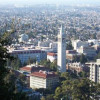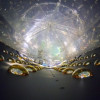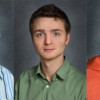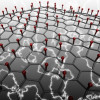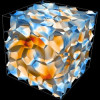News
Berkeley Lab-led Institute to Help Solve Data-intensive Science Challenges
As scientists around the world address some of society’s biggest challenges, they increasingly rely on tools ranging from powerful supercomputers to one-of-a-kind experimental facilities to dedicated high-bandwidth research networks. But whether they are investigating cleaner sources of energy, studying how to treat diseases, improve energy efficiency, understand climate change or address environmental issues, the scientists all face a common problem: massive amounts of data which must be stored, shared, analyzed and understood. And the amount of data continues to grow – scientists who already are falling behind are in danger of being engulfed by massive datasets. Read More »
Berkeley Lab Staff Offer Career Advice to Kennedy High School Students
Berkeley Lab Computing Sciences Communications staffers Jon Bashor, Margie Wylie and Linda Vu joined Rachel Carl and Jeff Todd of Berkeley Lab Human Resources in a presentation on finding rewarding jobs to juniors and seniors at Kennedy High School in Richmond on Wednesday, March 21.
Read More »
NSF to Help Campuses Embrace 'Science DMZ' Strategy
Scientists across America increasingly rely on remote instruments such as the future Large Synoptic Survey Telescope or the Large Hadron Collider (LHC), and computing facilities such as the National Energy Research Scientific Computing Center (NERSC) to conduct experiments, create simulations, and analyze data. Read More »
Researchers Discover a New Kind of Neutrino Transformation
Neutrinos, the wispy particles that flooded the universe in the earliest moments after the Big Bang, are continually produced in the hearts of stars and other nuclear reactions. Untouched by electromagnetism, they respond only to the weak nuclear force and even weaker gravity, passing mostly unhindered through everything from planets to people. Read More »
Carbon Dioxide Catchers
Approximately 45 percent of electricity used in the United States is produced by coal-burning power plants that spew carbon dioxide (CO2) into the atmosphere and contribute to global warming. To reduce this effect, many researchers are searching for porous materials to filter out the CO2 generated by these plants before it reaches the atmosphere, a process commonly known as carbon capture. But identifying these materials is easier said than done. Read More »
John Shalf's Paper is Among the Best in History of HPDC Conference
“The Cactus Code: A Problem Solving Environment for the Grid,” a paper co-authored by John Shalf of the Computational Research Division, has been selected as one of the top papers in the 20 years of publications from HPDC, the International ACM Symposium on High-Performance Parallel and Distributed Computing. Other authors of the paper, written in 2000, are Gabrielle Allen, Werner Benger, Tom Goodale, Hans-Christian Hege, Gerd Lanfermann, André Merzky, Thomas Radke and Edward Seidel. Read More »
A Roadmap for Engineering Piezoelectricity in Graphene
Some scientists refer to graphene as the “miracle material” of the 21st century. Composed of a single sheet of carbon atoms, this material is tougher than diamond, more conductive than copper, and has potential applications in a variety of technologies. Read More »
Berkeley Lab Staff Mentor High School Girls in Science Education App Development
Late Tuesday afternoons, as many Lab employees are heading down the Hill after work, a group of more than 60 high school girls from Berkeley and Albany heads up to Berkeley Lab for a series of 10 two-hour workshops to develop science education apps for Android smart phones. Read More »
New Mathematical Method Reveals Where Genes Switch On or Off
Developmental biologists at Stanford University, using computing resources at the U.S. Department of Energy’s National Energy Research Scientific Computing Center (NERSC), have taken a new mathematical method used in signal processing and applied it to biochemistry, using it to reveal the atomic-level details of protein–DNA interactions with unprecedented accuracy. They hope this method, called “compressed sensing,” will speed up research into where genes are turned on and off, and they expect it to have applications in many other scientific domains as well. Read More »
Berkeley Lab Mathematicians Win Cozzarelli Prize
James Sethian and Robert Saye, mathematicians who both hold joint appointments with the Lawrence Berkeley National Laboratory (Berkeley Lab) and the University of California (UC) Berkeley, have won the 2011 Cozzarelli Prize for the best scientific paper in the category of Engineering and Applied Sciences. Read More »







 Instagram
Instagram YouTube
YouTube